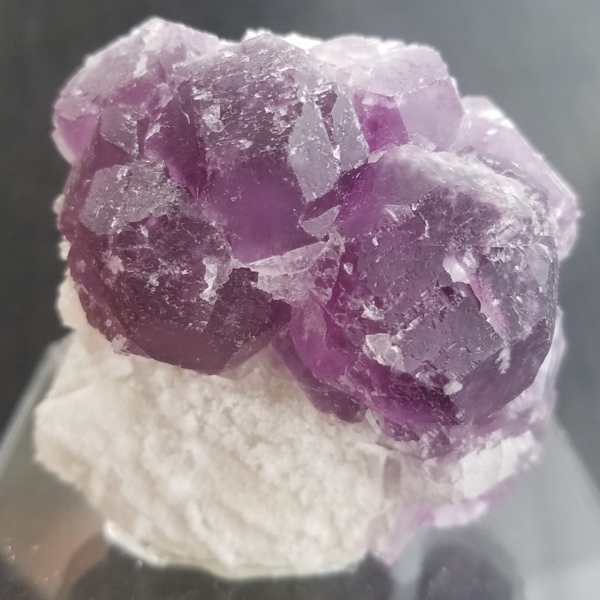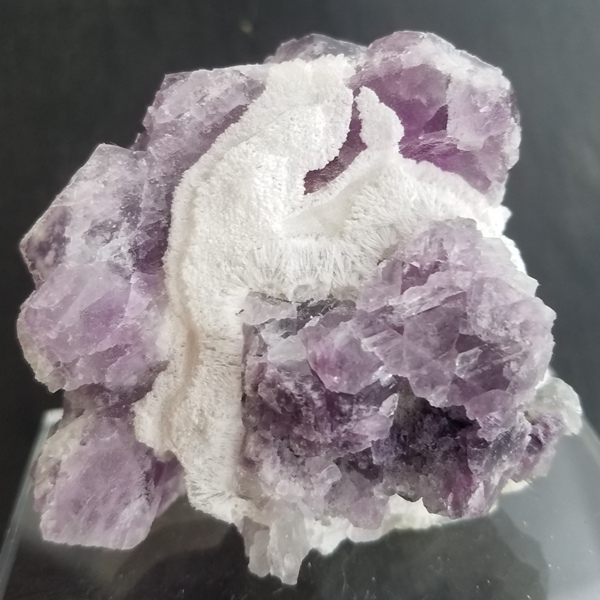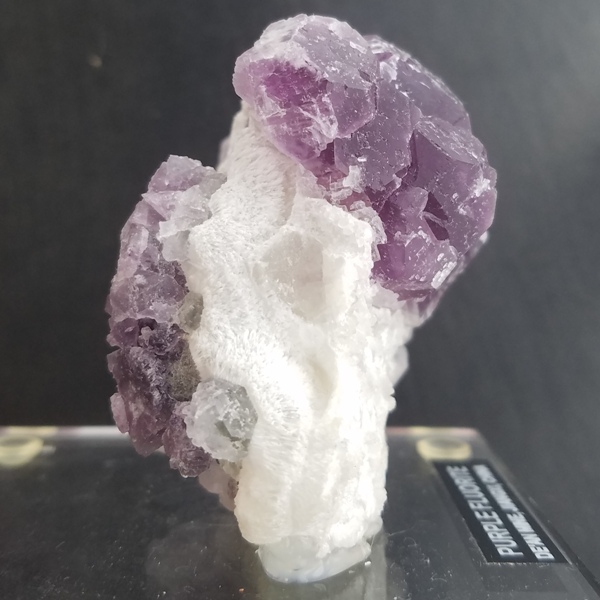No products in the cart.
- Sorry, this product cannot be purchased.
Crystals, Minerals of the World, Quartz
PURPLE FLUORITE QUARTZ
Availability:
Out of stock
A very aesthetic specimen of Purple Fluorite Quartz. Beautiful Purple Fluorite on a Chalcedony Quartz matrix. A very nice example of two popular minerals. This specimen is a combination of globular Fluorite. The contrasting colours add another dimension to this lovely crystal specimen. Add this cute little piece to your mineral or crystal collection. This type of Fluorite is very distinctive and collectable material. Mounted on perspex display pad for enhanced display.
Location:
De’an Mine, Jiangxi, China.
Dimensions:
6cm x 5.8cm x 4.8cm, 179g.
Calcium Fluoride: CaF2.
Compare
PURPLE FLUORITE QUARTZ
A very aesthetic specimen of Purple Fluorite Quartz. Beautiful Purple Fluorite on a Chalcedony Quartz matrix. A very nice example of two popular minerals. This specimen is a combination of globular Fluorite. The contrasting colours add another dimension to this lovely crystal specimen. Add this cute little piece to your mineral or crystal collection. This type of Fluorite is very distinctive and collectable material. Mounted on perspex display pad for enhanced display of Purple Fluorite Quartz.
Location:
De’an Mine, Jiangxi, China.
Dimensions:
6cm x 5.8cm x 4.8cm, 179g.
Calcium Fluoride: CaF2.
Fluorite
Calcium Fluoride
CaF2
Named in 1797 by Carlo Antonio Galeani Napione from the Latin fluere to flow. Used as a flux for smelting metals. The element fluorine also derives its name from fluorite, a major source for the element. Fluorite is a mineral with a bouquet of brilliant colours. Well known and prized for its glassy luster and rich variety of colours. The range of common colours for fluorite starting from purple, then blue, green, yellow, colorless, brown and pink. The most striking color is rainbow Fluorite which is hard to come by. Intermediate pastels between the previously mentioned colours are also possible. It is easy to see why fluorite earns the reputation as “The Most Colourful Mineral in the World”.
Check out more Fluorite for sale here.
Chemistry: CaF2, Calcium Fluoride
Class: Halides
Used in iron smelting, a rare gemstone, a source of fluorine, as special optical lenses and a popular mineral specimen.
Physical Properties.
Specimens
Fluorite is a mineral with a veritable bouquet of brilliant colors. Prized for its glassy luster and rich variety of colors. Amazing colors of purple, blue, green, yellow, colorless, brown, pink, black and reddish orange. Intermediate pastels between the previously mentioned colors are also possible. It is easy to see why fluorite earns the reputation as “The Most Colorful Mineral in the World”. The many colors of fluorite are truly wonderful. The rich purple color is by far fluorite’s most famous and popular color. It easily competes with the beautiful purple of amethyst. The colorless variety is not as well received, rarity still makes them sought after by collectors. A brown variety found in Ohio and elsewhere has a distinctive iridescence that improves an otherwise poor color for fluorite. The rarer colors of pink, reddish orange (rose) and even black are usually very attractive and in demand.
Fluorescence
Frequently fluorescent and, like its normal light colors, its fluorescent colors are extremely variable. Typically it fluoresces blue but other fluorescent colors include yellow, green, red, white and purple. Some specimens have the added effect of having a different color under UVA light from its color under UVC light. And some will even demonstrate phosphorescence in a third color! That’s four possible color luminescence in one specimen! If you count the normal light color too. Blue fluorescence is attributed to europium ions. Yttrium is the activator for the yellow fluorescence and maybe blue. Check out Rogerley Mine Fluorite.
Activators are rare earth metals; also manganese, uranium or a combination of these. Too much or too little often negates the fluorescence effect. The naming followed the naming precedence set by opalescence from opal; ergo fluorescence from fluorite.
More Coolness
Another unique luminescent property of fluorite is its thermoluminescence. Thermoluminescence is the ability to glow when heated. Not all fluorites do this, in fact it is quite a rare phenomenon. A variety of fluorite known as “chlorophane” can demonstrate this property very well. Activated by body heat in a dark room. Not bright enough to be seen in daylight.
The thermoluminescence is green to blue green and can be produced on a heater or electric stove. Once seen, the glow will fade away and can no longer by seen in the same specimen again. Chlorophane is found in limited quantities at Franklin, New Jersey, the Bluebird Mine, Arizona, USA. Also Gilgit, Pakistan, Mont Saint Hilaire, Quebec, Canada and Nerchinsk in the Ural Mountains Russia.
Crystal Form
Typical habit of fluorite is a cube and the color zones are often in cubic arrangement. The effect is similar to phantomed crystals that appear to have crystals within crystals that are of differing colors. One crystal of fluorite could potentially have four or five different color zones or bands.
Fluorite has other qualities besides its great color assortments that make it a popular mineral. It has several different crystal habits that always produce well formed, good, clean crystals. The cube is the most recognized habit of fluorite. Cleavage of fluorite can produce an octahedral shape and are popular in rock shops. The natural (e.g. uncleaved) octahedrons are harder to find.
The twelve sided dodecahedron is a rarer habit. Modifies the cubic crystals by replacing the edges of the cube with one flat face of a dodecahedron. Tetrahexahedron is a twenty four sided habit that is also a modifying the cubic habit. But instead of one face replacing each cubic edge, two faces modify the cube’s edges. Combinations of a cube, dodecahedron and tetrahexahedron can produce an overall cubic crystal. A fifth form is the hexoctahedron which modifies the cube by placing six minor faces at each corner. Twinning is also common in fluorite and symmetrical penetration twins, especially from Cumberland England are much sought after by collectors. Fluorite, as mention above, has octahedral cleavage. Four identical directions of cleavage and when cleaved in the right ways can produce a perfect octahedral shape.
Know
Associated with galena, pyrite, chalcopyrite, marcasite, golden barite, sphalerite, calcite and quartz. The origin of the word fluorite comes from the use of fluorite as a flux in steel and aluminum processing. Referred to as fluorospar by miners. Fluorite is a source of fluorine. Used for hydrofluoric acid and fluorinated water. The element fluorine also gets its name from fluorite, fluorines only common mineral.
Fluorite is the most popular mineral for mineral collectors in the world, second only to quartz. Every mineral collection owned by even the newest and youngest of mineral collectors must have a specimen of fluorite. Fluorite is by far one of the most beautiful and interesting minerals available on the mineral markets.
Properties
Color is extremely variable and many times can be an intense purple, blue, green or yellow; also colorless, reddish orange, pink, white and brown. Rainbow colored slabs are amazing.
Luster is vitreous.
Transparency: Crystals are transparent to translucent.
Crystal System: Isometric; 4/m bar 3 2/m
Crystal Habits include Cube, Octahedron and combinations of the two. Always with equant crystals; less common are crusts and botryoidal forms. Twinning also produces penetration twins that look like two cubes grown together.
Cleavage is perfect in 4 directions forming octahedrons.
Fracture is irregular and brittle.
Hardness is 4
Specific Gravity is 3.1+ (average)
Streak is white.
Other Characteristics
Often fluorescent blue or more rarely green, white, red or violet and may be thermoluminescent, phosphorescent and triboluminescent.
Associated Minerals are many and include calcite, quartz, willemite, barite, witherite, apatite, chalcopyrite, galena, sphalerite, pyrite and other sulfides.
Notable Occurrences include in addition to those mentioned above Cumberland, England; Spain; China; Brazil; Morocco; Bancroft, Ontario, Canada; Naica, Chihuahua, Mexico; Germany; Elmwood, Tennessee; Rosiclare, Illinois; Fort Wayne, Indiana; Pugh Quarry and Wood County, Ohio; Nancy Hanks Mine, Colorado and many other USA localities as well as many other localities from around the world.
Best Field Indicators are crystal habit, color zoning, hardness, fluorescence and octahedral cleavage.
Check out Fluorite for sale here
Fluorite Sample Images
| Weight | 200 g |
|---|---|
| Dimensions | 12 × 10 × 8 cm |
| color | Purple, White |
PURPLE FLUORITE QUARTZ
A very aesthetic specimen of Purple Fluorite Quartz. Beautiful Purple Fluorite on a Chalcedony Quartz matrix. A very nice example of two popular minerals. This specimen is a combination of globular Fluorite. The contrasting colours add another dimension to this lovely crystal specimen. Add this cute little piece to your mineral or crystal collection. This type of Fluorite is very distinctive and collectable material. Mounted on perspex display pad for enhanced display.
Location:
De’an Mine, Jiangxi, China.
Dimensions:
6cm x 5.8cm x 4.8cm, 179g.
Calcium Fluoride: CaF2.
You may also like…
- Crystals, Minerals of the World
PURPLE FLUORITE CELESTINE
A large specimen of rare Purple Fluorite Celestine. An all Celestine matrix, aesthetically displayed and very collectible. Great location too. This is a heavy piece for its size due to the strontium content of the Celestine.
Location:
Musquiz, Coahuila, Mexico.Dimensions:
10cm x 11cm x 9.5cm, 644g.Calcium Fluoride: CaF2.
Celestine: SrSO4.
SKU: MW0493 - Minerals of the World
FLUORITE CELESTINE
FLUORITE CELESTINE
Fluorite Celestine specimen – light purple Fluorite cubes on Celestine crystals. A heavy specimen for its size, with distinct crystals from both minerals. An interesting piece.
Dimensions:
7.6cm x 9cm x 4.5cm, 410gLocation:
Musquiz, Coahuila, MexicoSKU: MW7031 - Crystals, Minerals of the World
PURPLE GLOBULAR FLUORITE
A striking large specimen of Purple Globular Fluorite on a white matrix. This form has proven very popular around the world since it first appeared. It demonstrates why fluorite is such a popular stone, with the variety of shapes and colours it presents in. While it is globular, it still shows a few cubic faces. Love it!
Location:
De’an Mine, Jiangxi, China.Dimensions:
18cm x 12.6cm x 8.3cm, 1704g.CaF2 Calcium Fluoride.
SKU: MW5656






































